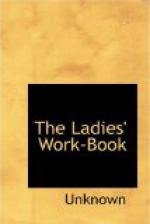ROSETTE (No. 13). This is exactly like a spider’s web, worked on three, four, or more threads, according to the shape of the space intended to be filled. Begin by making a Sorrento bar across the space, from one point to the opposite; then a second one, slipping the needle under the first in going, and over it in twisting back; then do a third, or fourth, if necessary; but when you have twisted back to the centre of the last, make the rosette, leaving the half bar single. The rosette is done by passing the needle under two threads, then continuing to slip it under two, the first of which is always the last of the previous two, until you have made the spot a sufficient size, when you finish the last bar, by twisting down to the braid, and fastening off. The size of the space must be the guide for that of the rosette; but from six to ten times round a centre is an average.
[Illustration: STITCHES.]
BRUSSELS LACE (No. 14). Consecutive rows of Brussels edging, worked alternately from left to right, and from right to left.
VENETIAN LACE (No. 15). Rows of Venetian edging. As this stitch can only be worked from left to right, a line of Brussels is usually placed between every two rows, and being worked from right to left, saves the trouble of running the needle along the braid.
SORRENTO LACE (No. 16). Successive rows of the Sorrento edging.
ENGLISH LACE (No. 17). This is to be worked with the finest thread that is made. Do a number of Sorrento bars (closely twisted threads), at equal distances, in one direction throughout the space: then take one thread under all these, in exactly the opposite direction; take a stitch on the braid to secure it, and twist to the first cross. Pass the needle under the single thread and over the twisted one, till it has gone four times round, when the spot will be sufficiently large. Twist on the single thread to the next cross, and repeat. Do this until the whole space is filled, as seen in the engraving, where the distance between the threads is sufficiently accurately represented. This lace always looks best, however, when the lines are diagonal. English lace is often radiated; that is, the lines are more distant from each other at one edge than at the other, and the spots proportionably larger, presenting the appearance of a fan.
[Illustration: OPEN ENGLISH LACE.]
[Illustration: BRABANT EDGING.]
OPEN ENGLISH LACE (No. 18). This is a variety of the previous lace, being worked in the same way, but on four lines of threads, instead of two, namely, one diagonal from left to right, one from right to left, one horizontal, and one perpendicular. The spots are worked on the last line made. The distance of the lines is seen in the engraving.
[Illustration: LYONS POINT.]
[Illustration: BRUSSELS LACE.]
The accompanying diagram gives another variety of open English lace. The straight bars are formed of single threads, while the diagonal ones are twisted; and at every cross a tight button-hole stitch is worked, to keep the threads together. Observe, that in working bars, a tight stitch should always be taken on the braid, at the beginning and end of every one.




